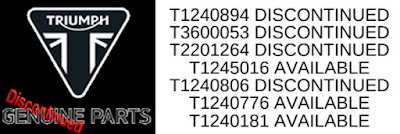If you follow the blog you'll know I'm on a mission to get my 2003 Triumph Tiger 955i to roll over into six figures on the odometer. I picked up the bike with under forty-K on it and have done the majority of the now high miles on it. Over that time I've had an ongoing battle with the early fuel injection on the bike, but other than that it has been my preferred ride even as a series of other bikes passed through the garage.Once again the fueling has gone off on the bike just as I was hoping to push it over the 100k mark in its 20th year on the road. If I lived somewhere where the weather wasn't trying to kill me for four months of each year this would be an easier goal, but trying to do it in Canada where the bike has to sit through minus forty winters and then navigate the frost heaved results in our too-short riding season? It's technical a flex I'm up for, but it's a shame that Triumph isn't.
I tried the usual solution of rebalancing the fuel injectors, but the bike is still stalling out and running rough. I checked the valves less than 15k ago so that isn't likely it. If it isn't throttle body balancing, which the bike is prone to needing, perhaps it's time to, at over 90k, to finally replace the o-rings and gaskets in the fuel injection system, but Triumph tells me that the majority of these parts are discontinued.
One of the reasons I enjoy the old Tiger is that it still catches eyes and prompts conversation when I'm out and about. Another reason I like it is that it can pretty much do anything (I've trail ridden on it and done multi-thousand mile two-up road trips too). It fits me better than anything I've ridden, is fun to chuck around in corners and has handled axle deep mud when I needed it to. The engine is full of character and pulls well even two up and, considering the miles it has done, the amount of TLC needed isn't unreasonable. I'd love to keep this bike going indefinitely, it's a shame that Triumph don't feel the same way.
I had a chat with the dealer (who isn't particularly local, it's a 170 mile round trip to go there physically - I usually get parts delivered), and they said that this is a problem with Triumph - they don't support their older machines. He then went on to say I couldn't use generic o-rings because the Triumph parts are strangely size specific. I'm going to try anyway because I really want to be able to jump on my old Tiger and ride.
Suzuki runs a successful vintage parts program so I'm not sure why Triumph wouldn't want to do the same to keep their bikes on the road, especially when they lean on brand heritage marketing so much.
Here's Nick Bloor's take on it:
Never standing still, always pushing to get the best from ourselves, for our riders. Building iconic motorcycles that celebrate our past while embracing the future through bold design, original styling, purposeful engineering and a genuine passion for the ride.
Always focused on delivering complete riding experience, creating bikes with the perfect balance of power, handling and style that totally involve the rider and bring out the best in them.
This is our passion and our obsession.
We are chasing the same thing as our riders THE PERFECT RIDE.
Nick Bloor
CEO Triumph Motorcycles
All good stuff, but maybe focus a bit more on celebrating Triumph's past, Nick? That includes the bikes your reborn Triumph have been making since the nineties. For some of us you created that perfect ride a while back.
















































